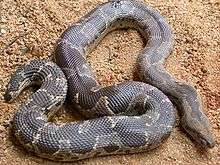Gongylophis conicus
| Gongylophis conicus | |
|---|---|
 | |
| Scientific classification | |
| Kingdom: | Animalia |
| Phylum: | Chordata |
| Subphylum: | Vertebrata |
| Class: | Reptilia |
| Order: | Squamata |
| Suborder: | Serpentes |
| Family: | Boidae |
| Subfamily: | Erycinae |
| Genus: | Gongylophis |
| Species: | G. conicus |
| Binomial name | |
| Gongylophis conicus (Schneider, 1801) | |
| Synonyms | |
| |
- Common names: rough-scaled sand boa,[2] rough-tailed sand boa.
Gongylophis conicus, also known as Russell's boa or rough-scaled sand boa, is a non-venomous boa species found in India, Bangladesh, Pakistan and Sri Lanka. No subspecies are currently recognized.[3]
Description

Adults may attain a total length 3 feet 3 inches (99 cm), which includes a tail 3 inches (76 mm) long.
The anterior maxillary and mandibular teeth are longer than the posterior. The head is covered with small scales. The eye is small with a vertical pupil. The dorsal scales are small and keeled. The tail is pointed, not or but very slightly prehensile.[4]
The rostral scale is twice as broad as long, slightly prominent, without an angular horizontal edge. The top of the head is covered with small obtusely keeled scales, except for the nasals and internasals which are enlarged. Interorbitals: 8 to 10. Circumorbitals: 10 to 15. The eye is separated from the labials by one or two rows of scales. Supralabial scales: 12 to 14. Dorsal scales tubercularly keeled, in 40 to 49 rows. Ventral scales: 162-186. The anal scale is single. Subcaudals: 17-24.[4]
The anterior dorsal scales are only feebly keeled, but these keels increase in size posteriorly to the point that they become so heavily keeled that it can make a squirming specimen really painful to handle. This also makes it look as if the front and rear ends belong to markedly different animals.[5]
Dorsally, the color pattern consists of a broad zigzag band or a series of dark brown blotches on a yellowish or brownish grey ground color. The belly is uniform white.[4]
In India it can be mistaken at first glance for either the Indian python, Python m. molurus, or the deadly Russell's viper, Daboia russelii.
Active at night, it feeds on worms and small mammals.
Geographic range
Found in eastern Pakistan, India south of about 30°N latitude, Bangladesh and in the northern arid region of Sri Lanka. The type locality given is "India orientali."[1]
Habitat
Sandy tracts of central and southern India, the Punjab, Kachchh and Sind. It is also found in Meghalaya.
See also
- List of erycine species and subspecies
- Erycinae by common name
- Erycinae by taxonomic synonyms
References
- 1 2 McDiarmid RW, Campbell JA, Touré T. 1999. Snake Species of the World: A Taxonomic and Geographic Reference, Volume 1. Washington, District of Columbia: Herpetologists' League. 511 pp. ISBN 1-893777-00-6 (series). ISBN 1-893777-01-4 (volume).
- ↑ Mehrtens JM. 1987. Living Snakes of the World in Color. New York: Sterling Publishers. 480 pp. ISBN 0-8069-6460-X.
- ↑ "Eryx conicus". Integrated Taxonomic Information System. Retrieved 8 July 2008.
- 1 2 3 Boulenger GA. 1893. Catalogue of the Snakes in the British Mueum (Natural History). Volume I., Containing the Families ... Boidæ ... London: Trustees of the British Museum (Natural History). (Taylor and Francis, printers). xiii + 448 pp. + Plates-XXVIII. (Eryx conicus, pp. 122-124).
- ↑ Ditmars RL. 1933. Reptiles of the World. Revised Edition. New York: The MacMillan Company. 329 pp. 89 plates.
Further reading
- Boulenger GA. 1890. The Fauna of British India, Including Ceylon and Burma. Reptilia and Batrachia. London: Secretary of State for India in Council. (Taylor and Francis, printers). xviii + 541 pp. (Gongylophis conicus, p. 247, Figure 75).
- Das I. 2002. A Photographic Guide to Snakes and Other Reptiles of India. Sanibel Island, Florida: Ralph Curtis Books. 144 pp. ISBN 0-88359-056-5. (Eryx conicus, p. 13).
- Gray JE. 1849. Catalogue of the Specimens of Snakes in the Collection of the British Museum. London: Trustees of the British Museum. (Edward Newman, printer). xv + 125 pp. (Gongylophis conica [sic], p. 108).
- Günther ACLG. 1864. The Reptiles of British India. London: The Ray Society. (Taylor and Francis, printers). xxvii + 452 pp. + Plates I-XXVI. (Gongylophis conicus, p. 333).
- Jones C. 2004. Sandboas. Reptilia 9 (3): 20-30.
- Schneider JG. 1801. Historiae Amphibiorum naturalis et literariae Fasciculus Secundus continens Crocodilos, Scincos, Chamaesauras, Boas, Pseudoboas, Elapes, Angues, Amphisbaenas et Caecilias. Jena: F. Frommann. vi + 374 pp. + Plates I-II. (Boa conica, new species, p. 268). (in Latin).
- Smith MA. 1943. The Fauna of British India, Ceylon and Burma, Including the Whole of the Indo-Chinese Sub-region. Reptilia and Amphibia, Vol. III.—Serpentes. London: Secretary of State for India. (Taylor and Francis, printers). xii + 583 pp. (Eryx conicus, pp. 112–113).
- Tokar AA. 1995. Taxonomic revision of the genus Gongylophis Wagler 1830: G. conicus (Schneider 1801) and G. muelleri Boulenger 1892 (Serpentes Boidae). Tropical Zoology 8 (2): 347-360.
- Whitaker R, Captain A. 2004. Snakes of India: The Field Guide. Chennai: Draco Books. 495 pp. ISBN 978-81-901873-0-5.
External links
| Wikimedia Commons has media related to Gongylophis conicus. |
- Gongylophis conicus at the Reptarium.cz Reptile Database. Accessed 8 July 2008.